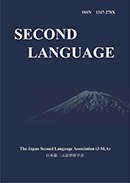Volume 21
Displaying 1-7 of 7 articles from this issue
- |<
- <
- 1
- >
- >|
PART I
CONTRIBUTIONS FROM J-SLA EARLY SUMMER SEMINAR 2021
-
2022Volume 21 Pages 7-22
Published: December 15, 2022
Released on J-STAGE: February 25, 2023
Download PDF (1006K) -
2022Volume 21 Pages 23-33
Published: December 15, 2022
Released on J-STAGE: February 25, 2023
Download PDF (479K) -
2022Volume 21 Pages 35-50
Published: December 15, 2022
Released on J-STAGE: February 25, 2023
Download PDF (726K) -
2022Volume 21 Pages 51-68
Published: December 15, 2022
Released on J-STAGE: February 25, 2023
Download PDF (744K)
PART II
ARTICLES: SUBMISSIONS FROM J-SLA ANNUAL CONFERENCES
<Contribution from J-SLA 2020>
-
2022Volume 21 Pages 71-87
Published: December 15, 2022
Released on J-STAGE: February 25, 2023
Download PDF (1116K)
<Contribution from J-SLA 2021>
-
2022Volume 21 Pages 89-113
Published: December 15, 2022
Released on J-STAGE: February 25, 2023
Download PDF (900K) -
2022Volume 21 Pages 115-132
Published: December 15, 2022
Released on J-STAGE: February 25, 2023
Download PDF (428K)
- |<
- <
- 1
- >
- >|
